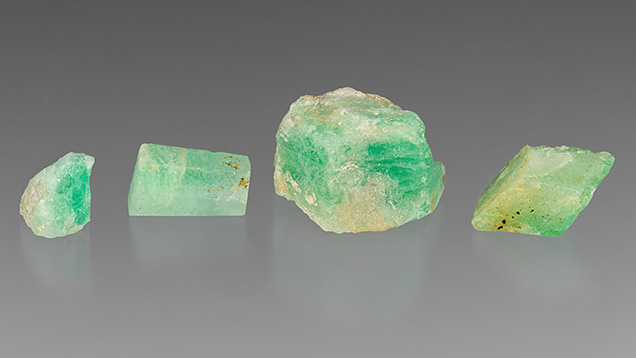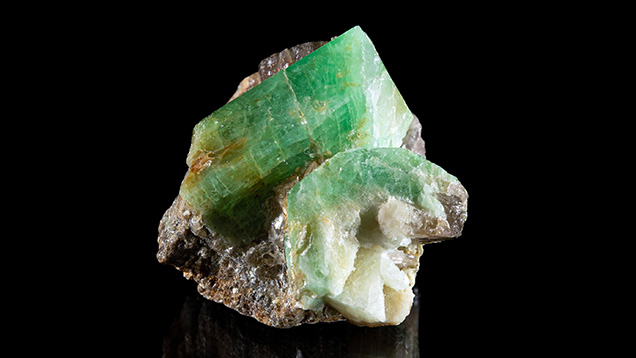Beryl from Newfoundland, Canada


Prospectors Art Gardner and Terry Russell recently discovered concentrically zoned beryl [Be3Al2(Si6O18)] in central Newfoundland, Canada, along the Bay D’Espoir Highway, and sent preliminary findings to GIA’s Carlsbad laboratory. The green rims of these beryls were often sufficiently green to be considered emerald. The outer rims were bright green or pale green, and the cores were very pale green or white (figures 1 and 2). Most zones had low transparency. They formed hexagonal columns at the 1–3 cm scale, associated with mica-quartz-feldspar veins and minor tourmaline, calcite, biotite, fluorite, pyrite, and arsenopyrite. Some stones were suitable for polishing and setting in jewelry, especially as cabochons. An individual specimen may have zones that fit into the definitions of emerald and white beryl, with the brighter greens at the rims.
Canada is host to a number of gem minerals, including emerald from Yukon and the Northwest Territories (G. Giuliani et al., “Emerald deposits: A review and enhanced classification,” Minerals, Vol. 9, 2019). This beryl deposit on Newfoundland Island is within the Great Bend Complex of ophiolites. The mica-quartz-feldspar veins hosting the beryl are found within a host rock rich with scheelite [Ca(WO4)]. Other pegmatitic dikes are regularly found within the bedrock, and a ~450 km belt of beryl-bearing pegmatite dikes extends across the island from east to west. This discovery adds another locality to Canada’s gemological map.

The ultraviolet/visible/near-infrared (UV-Vis-NIR) absorption spectrum of the green zone in the leftmost crystal in figure 1 displayed absorption bands at 420 (Fe3+), 615 (V3+, Cr3+), and 835 nm (Fe2+) and a sharp but low absorption peak at 956 nm (H2O) (figure 3). These are due to the combined effects of vanadium and iron, with minor influence of chromium. These features are common in emerald.


The beryls’ chemistry, as determined by laser ablation−inductively coupled plasma−mass spectrometry (LA-ICP-MS), is unique from other worldwide deposits; both the white cores and green rims had elevated lithium and cesium (figure 4). The lithium and cesium values are within the range expected more of a beryl from a lithium-cesium rich pegmatite, such as many morganites or goshenites. The green coloration is primarily due to vanadium, with minor chromium, which are both chromophores of emerald (table 1). The magnesium is consistently higher than iron, as expected for emeralds (R.E. Henry et al., “Crystal-chemical observations and the relation between sodium and H2O in different beryl varieties,” Canadian Mineralogist, Vol. 60, 2022, pp. 625–675). The magnesium and transition metals are higher in the green rims than in the white cores, which have higher lithium. However, the cesium is higher in the green rims. This is likely due to the near-mutual exclusivity of beryllium site and aluminum site cation substitutions, preventing significant lithium substitutions when there is a high level of magnesium and transition metals (R.E. Henry et al., “Predicting the crystal structure of beryl from the chemical composition,” Canadian Journal of Mineralogy and Petrology, Vol. 61, No. 4, 2023, pp. 873–897). As magnesium and iron require charge balancing, sodium and cesium can serve this purpose; while cesium is associated with lithium in geologic environments, it does not have the same crystal-chemical constraints as lithium in beryl.
These beryls’ formation at the intersection of an ophiolite and a pegmatite is consistent with conditions required to create emerald as it brings together a source of vanadium or chromium with a source of beryllium. The goshenite cores are a feature that have been seen in emeralds from some other localities, including Russian emeralds.
Due to their uniquely high cesium and lithium, emerald zones of beryl from this locality are easy to differentiate. Should gem-quality specimens come to the market, a method is in place to confirm their origin as Newfoundland. Efforts are underway to continue exploration for additional gem material.



